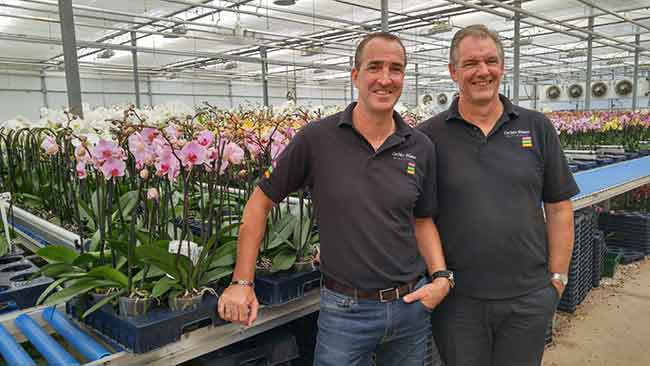
Features
Energy
Management
Energy savings: manage what you measure
Energy data helps reduce costs, manage risks and optimize yield
October 25, 2016 By James Williams and Jennifer Niece
 Mike and Neil van Steekelenburg of CosMic Plants. 360 ENERGY
Mike and Neil van Steekelenburg of CosMic Plants. 360 ENERGYNovember 2016 – Greenhouses provide vegetable and flower growers with the ability to control all the inputs needed to yield healthy, plentiful crops. In a greenhouse, growers can tailor the amount of light, CO2, moisture, heat and cold, and other variables in order to improve both the quality and quantity of their production.
Maintaining this climate, and modifying it as needed, requires careful monitoring and state-of-the-art technology. What is often overlooked is the role energy plays in the growing process, and how that energy impacts overall profitability.
CosMic Plants is one of the growers doing it right. The Beamsville-based greenhouse, owned by brothers Neil and Mike van Steekelenburg, grows orchids. Their plants are incredibly sensitive to ambient conditions and require constant monitoring to ensure the climate is perfect. Neil and Mike use their Hoogendoorn automation system to control the environment, gathering data on light input, temperature, moisture levels and more to ensure that everything is running as perfectly and efficiently as possible.
CosMic saw the value in applying this same efficient, perfectionist approach to how they manage their energy use, and engaged the expertise of Ancas-ter-based consulting company 360 Energy to ensure a comprehensive approach and optimal savings.
According to 360 Energy CEO David Arkell, “360 Energy collects and analyzes CosMic’s electricity and natural gas usage data to provide site-specific guidance on savings opportunities. We combine this information with our knowledge of energy markets to achieve further savings through energy procurement, always keeping in mind that production, and the health of the plants, comes first.”
This meticulous tracking of energy data helps the greenhouse make better decisions on how and when to use energy. Applying this combination of tactics, a typical grower can expect to see a 15 to 25 per cent reduction in energy costs.
You can’t manage what you can’t measure and there are multiple types of data that should be captured to accurately understand how energy is used within a greenhouse.
The right data must be coupled with careful analysis and knowledge of how to interpret it to maximize energy savings without impacting yield. The data management support provided by 360 Energy provides this expertise, allowing growers to track and understand energy usage and energy billing and use the information gathered to make better, more informed energy decisions. Data such as monthly, weekly, daily and even hourly natural gas and electricity usage can be used to discover how efficiently equipment is working, providing a means to catch potentially costly abnormalities early.
Once all the necessary data is captured, a baseline can be established to evaluate ongoing performance and the effectiveness of changes to processes and equipment.
By comparing current performance to the baseline established, growers can see whether the changes implemented have had the desired effect on energy usage.
As the Canadian greenhouse industry expands and seeks to extend growing seasons with new lighting technology, attention to the cost and strategic usage of these technologies will become even more important to make cold-season production more profitable. As CosMic says, “360 Energy gives us comprehensive and independent advice. That allows us to be better risk managers and to become ever more efficient when it comes to the energy component in our operational cost of growing quality orchids.”
Written by James Williams and Jennifer Niece of 360 Energy. The company is one of North America’s leading energy services firms. To view a video on this project, follow this link: www.360energy.net/2016/10/hear-how-cosmic-plants-is-managing-energy-costs/
Print this page